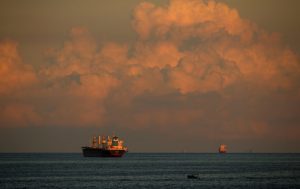Dampier and Port Hedland could host ship-to-ship refuelling with green ammonia, which can be produced in the area by tapping into the region’s massive wind and solar potential, a new report says.
The Yara Clean Ammonia and Pilbara Ports study looked at whether green ammonia could be used to refuel iron ore carriers, a key focus as the region’s giant miners look to slash emissions to meet international demands for low carbon products.
The study found that Dampier and Port Hedland had enough anchorages to allow ship-to-ship bunkering, a process that normally happens offshore, and that existing ammonia production and liquids export infrastructure could be rejigged to produce and deliver green ammonia.
The study comes days after Norwegian company Yara Clean Ammonia cut deals with Höegh Autoliners to fuel its new new Aurora-Class PCTC vessels and with NorthSea Container Line to power its latest vessel on the Norway-Germany route.
With maritime transport accounting for 2.8 per cent of global CO2 emissions, or 706 million tonnes of CO2 globally in 2022, some shipping operators are looking for alternative fuels.
Ammonia has been transported on ships for some time, but stepping up to use it as a fuel requires a range of new practices because of its well-known toxicity.
Ship-to-ship bunkering is a dangerous practice anyway, but bringing a new kind of flammable, corrosive and toxic substance into the mix means more infrastructure and new safety measures need to be put in place.
Exhaust gas from ammonia-fueled engines contains nitrogen oxides and nitrous oxide, which requires onboard scrubbing technology and offshore refuelling.
Some of the challenges around using ammonia – green or not – as a shipping fuel include its low density which means more needs to stored onshore and used for refuelling, and would need significantly larger bunkering – as much as three times as that required for commonly used fuels.
Bunkering also needs to be redesigned so spill control equipment can handle larger volumes as well as toxic gas, and special protections must be installed to detect and protect the crew from potential leaks.
Depending on forecast demand
The Pilbara study suggested that demand by iron ore shippers for ammonia as a decarbonising shipping fuel could reach 1 million to 1.5 million tonnes in 2035.
The International Energy Agency suggests that globally, green ammonia might be able to cover 44 per cent of maritime fuel use by 2050.
Yara Clean Ammonia executive Murali Srinivasan said the level of demand was a reflection of decarbonisation efforts in the iron ore and steel industries, which are coming under closer scrutiny for their environmental practices.
He said the Yara Pilbara Fertilisers ammonia plant near Karratha was one way to meet this demand.
“The current development of Yuri renewable hydrogen project on the Yara Pilbara site will be the first in Australia to inject green molecules into an existing ammonia plant, and Yara is vigorously exploring options to ramp up volumes of clean and low carbon ammonia to lay the foundation for a reliable supply chain to serve the emerging shipping fuel market,” he says.
The kinds of bulk carriers catered to by ports in the Pilbara, which handle the mass export of minerals from Western Australia, are the natural starting point for new marine fuels, says Pilbara Ports CEO Samuel McSkimming.
“Last year we achieved 752.4 million tonnes of trade with more than 6,829 vessel visits. This scale of operations cannot be found anywhere else in the world, and it makes the Pilbara’s ports the natural beachhead from which the global bulk carrier fleet will decarbonise,” he says.
“Ammonia is already widely produced, used, and shipped in industrial quantities around the world… The study is an important step towards implementing safe ship to ship ammonia bunkering at our anchorages in Dampier and Port Hedland.”









